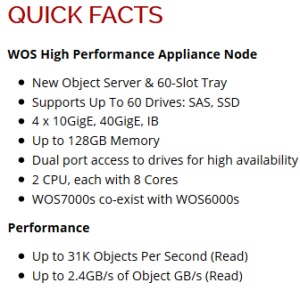When it comes to archiving of important research or mission-critical data, organizations are left with making tough decisions around investing in expensive tier-1 storage to keep up with data volume and performance requirements. Beyond that option, using file systems that might be too complex for data that isn’t often modified, moving to tape where access times may be slower, or taking other approaches that might not meet cost, performance, collaboration capability, or other demands are the next best set of choices.
Scality, Cleversafe and others have sought to address the problems of holding onto mostly-static data with their object storage approaches, which were aimed at enterprise users. But according to Data Direct Networks, their roots in high performance computing environments, blended with some lessons learned from those competitors in the object storage space for mainstream business provide a useful alternative for HPC environments that are facing expensive storage scenarios for data that’s not often altered but still needs to be readily accessible.
According to DDN’s Michael King, around 80% of data is modified once and never again, although it might be pulled in for other points of analysis. This means that users “don’t require the complexity of a lot of the high performance file systems, they want to put their data in scalable, low cost storage, but until now, they haven’t had the tunability needed.” He says that further, high performance computing sites have been limited in that they can’t collaborate on datasets if they choose tape, are limited in terms of the cost of NAS, and thus need a “happy medium” that allows collaboration, accessibility, and cost effectiveness.”
With this in mind, DDN announced WOS 360 Full Spectrum Object Storage this week, which is tuned to address the challenges mentioned. They’re not new to object storage, but this is the first time they’ve offered some of the tuning and other features that gave some of their competitors a leg up in content delivery, media, web services and other areas. King says it will let users scale in terms of number of objects, capacity and sites and offer the IOPS boost that one would expect from an HPC-oriented vendor.
There are several ways to access it, as seen below, which go beyond the programmatic hassles of using native object storage approaches. Users can tap in file gateways and through a number of file systems, although despite the emphasis on HPC, Lustre is not present yet, though King says it’s definitely on the roadmap given their hope to offer something for HPC here. He points to the iRODS hook as one feature, but notes they’re expanding in the future.
Another key element on the reliability front is in the ObjectAssure side of WOS 360. Their erasure coding approach uses up to three different nodes to store data, which is then broken into smaller bits and kicked about to those three nodes. This means in the unfortunate event of losing one of those nodes completely, it’s still possible to reproduce the data. This is not new—however, King says that what makes their approach different is that the rebuilding process on other similar approaches requires heavy traffic across the WAN, which dings users on performance. Their ObjectAssure can rebuild each copy of the three nodes locally in the event of a stalled drive on a local node. “It’s high performance in that sense, but it’s also aimed at the deep, cheap archive” approach.
WOS 360 is available in a software-only mode, but the focus during King’s discussion with us was on the WOS High Performance Appliance, the WOS Archive Appliance or their partner, Hyve’s, OCP-Ready Appliance.
 The high performance appliance node details are to the left.
The high performance appliance node details are to the left.
During a conversation with the company’s new CMO, Molly Rector, (who moved over to DDN from tape storage vendor, SpectraLogic recently), the object storage market is important to DDN’s growth because it offers the flexibility for users to deploy many applications along the same infrastructure lines.
She says that DDN is expecting to see massive growth in new markets in mainstream enterprise, as well as keep a firm foothold in HPC by making sure that they’re delivering what HPC sites need the most—storage options that keep price in mind as well as performance.






























































